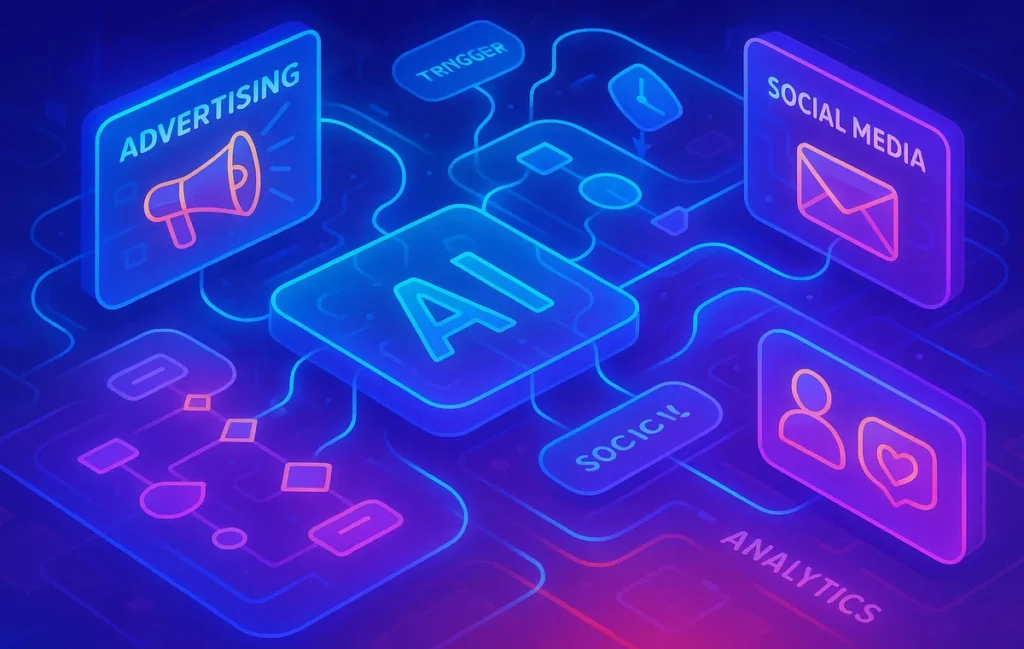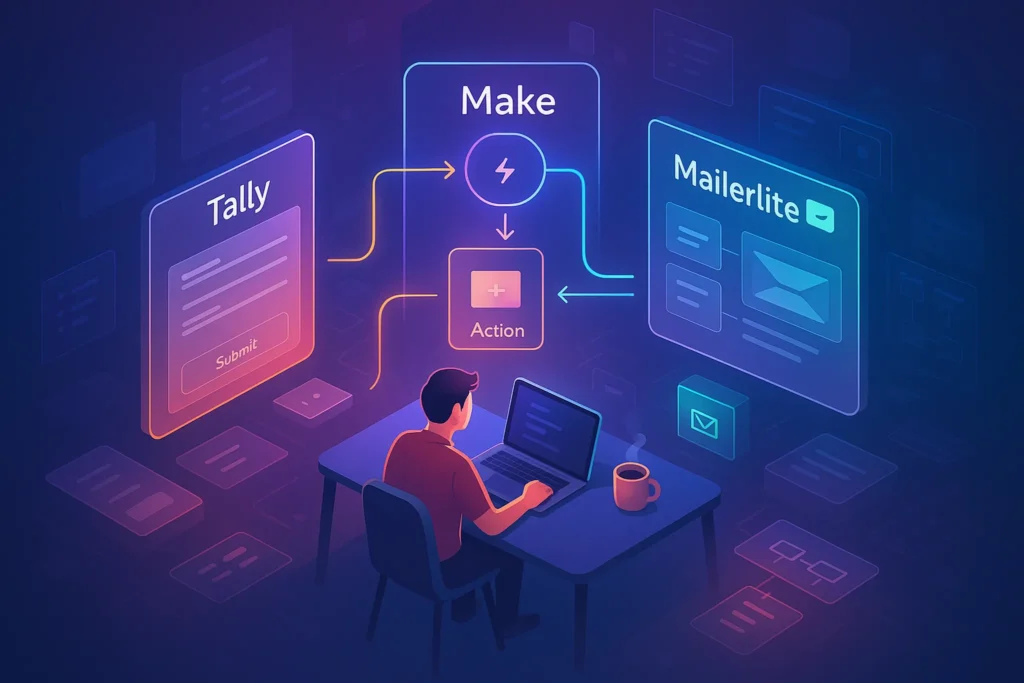⚡ Why Workflow Automation Matters for Marketers in 2025
Marketing in 2025 isn’t about working harder—it’s about building smarter systems. Campaigns now span multiple channels: TikTok, email funnels, paid ads, and long-form content. Without automation, marketers drown in repetitive tasks like scheduling posts, generating reports, or qualifying leads.
Workflow automation platforms transform this reality. They replace manual effort with AI-driven processes, allowing teams to focus on strategy and creativity. In fact, benchmark reports show companies adopting automation in their marketing stack see up to 20% higher ROI within the first year. That’s because time once wasted on repetitive work gets reinvested into growth activities.
At NerdChips, we’ve observed that marketers who fully embrace automation—not just dabble in it—gain a real competitive edge. It’s not about replacing humans, but freeing them to do the kind of work algorithms can’t: storytelling, creative positioning, and customer empathy.
💡 Nerd Tip: Think of automation as your backstage crew. The smoother they run the operations, the more your brand shines on stage.
🧩 What Defines a Strong Workflow Automation Platform?
Not all automation tools are created equal. For marketers, the best platforms combine:
-
Ease of Use: Drag-and-drop builders or no-code interfaces so marketing teams don’t need engineers to build workflows.
-
AI Intelligence: Predictive triggers and adaptive logic that go beyond simple “if this, then that” rules.
-
Integration Depth: Ability to connect with ad platforms, CRMs, email tools, and social media.
-
Scalability: Systems that handle growth—going from 10 workflows to 1,000 without collapsing.
We explored this in Best Workflow Automation Tools for Solopreneurs & Remote Teams, but in 2025, the bar has risen. Platforms now actively recommend automations, not just execute what you design.
🛠️ The Top Workflow Automation Platforms for Marketers in 2025
🌐 Zapier AI
Zapier has been a pioneer, but its AI upgrades in 2025 have made it indispensable for marketers. Instead of building workflows from scratch, you can describe what you want in natural language—“Connect my Facebook Ads to Slack so I get notified when CPA rises above $15.” Zapier AI designs the automation for you.
Marketers praise how it predicts useful zaps based on campaign data. One user on X said: “Zapier AI is like having a marketing ops assistant. It literally suggests automations I didn’t know I needed.”
💡 Nerd Tip: Start with AI-suggested automations. Many marketers discover 2–3 processes they’d never thought to automate this way.
⚡ Make (formerly Integromat)
Make is the choice for marketers who want visual clarity. Its workflow builder resembles a mind map where you can see every step of your campaign automation—perfect for mapping customer journeys.
In 2025, Make added AI data enrichment, meaning it can pull missing details (like company size or industry) from a lead’s email before sending them into your CRM. For B2B marketers, this is a game changer. Compared with traditional manual lead qualification, it reduces errors and accelerates pipeline velocity.
📊 HubSpot Operations Hub
For marketing teams already inside HubSpot, Operations Hub is the natural choice. Its strength lies in unifying data across sales, marketing, and service. In 2025, HubSpot rolled out AI-driven “data hygiene,” automatically merging duplicates and correcting bad CRM records.
For campaign managers, this means cleaner lists, fewer wasted emails, and more reliable segmentation. As we noted in Pro Tips for Automating Your Entire Content Workflow, clean data isn’t glamorous, but it’s the foundation of effective automation.
🔄 n8n
n8n is the open-source darling of automation. Marketers love it because it’s flexible and affordable compared to enterprise SaaS. In 2025, its new plugin ecosystem allows easy integration with niche marketing tools—perfect for startups that don’t run on standard stacks.
The biggest advantage? You own your workflows. Unlike closed systems, n8n lets you host locally or in the cloud, giving marketers more control over data privacy and customization.
🤖 HARPA AI
HARPA AI stands out as a browser-native automation assistant. Marketers use it to scrape competitor insights, monitor campaign keywords, or even auto-generate performance summaries. In 2025, its upgraded Chrome assistant can combine real-time web monitoring with scheduling triggers, creating lightweight workflows without servers.
This tool resonates with solopreneurs and growth hackers looking to automate research-heavy processes. As detailed in Automate Your Side-Hustle, HARPA turns internet browsing itself into a trigger for workflows.
⚡ Ready to Build Smarter Workflows?
Explore AI workflow builders like HARPA AI, Zapier AI, and n8n plugins. Start automating in minutes—no coding, just creativity.
🔍 How Marketers Can Apply Automation Day-to-Day
The power of workflow automation lies in practical applications:
-
Social Media: Auto-scheduling posts across TikTok, Reels, and LinkedIn while syncing performance data back to dashboards.
-
Email Marketing: Trigger personalized campaigns based on user behavior in real time.
-
Reporting: Auto-generate weekly campaign performance reports and deliver them to Slack.
-
Lead Nurturing: Score, qualify, and assign leads without manual review.
The magic happens when automations chain together. Imagine a workflow: someone downloads your lead magnet, Zapier sends data to HubSpot, HubSpot segments them, and Make triggers a personalized email series. What used to take hours now happens in seconds.
💡 Nerd Tip: Start by automating tasks you repeat at least five times per week. Those deliver the highest time ROI.
📌 Mini Case Study: Real ROI from Automation
Consider an e-commerce brand that was struggling with reporting fatigue. Every Monday, the marketing team spent nearly six hours gathering ad performance data from Meta Ads, Google Ads, and TikTok campaigns. By introducing Zapier AI and HubSpot Operations Hub, the team fully automated reporting. Dashboards were updated in real time, and summaries landed in Slack without anyone lifting a finger.
Within three months, not only had the team reclaimed 24 work hours per month, but campaign optimization accelerated because decisions were based on fresher data. The result: a 15% increase in click-through rates and a 10% reduction in wasted ad spend.
One marketer tweeted: “Automation didn’t just save time—it gave us clarity. We stopped debating numbers and started fixing campaigns.”
💡 Nerd Tip: Track ROI from automation not only in hours saved, but also in improved campaign outcomes.
⚠️ Common Mistakes in Marketing Automation
While automation is powerful, misuse can backfire. A common mistake is over-automation—trying to automate nuanced tasks like personalized customer interactions that still require human judgment. This often results in robotic experiences that damage brand trust.
Another pitfall is ignoring data hygiene. If your CRM is cluttered with duplicates or outdated contacts, automation only accelerates chaos. As discussed in Best No-Code Automation Tools for Small Business Owners, clean data is the foundation of reliable automation.
Finally, marketers often forget to review workflows regularly. An automation that made sense six months ago may now be irrelevant—or worse, harmful. For example, sending onboarding emails to customers who already churned because no one updated the workflow logic.
💡 Nerd Tip: Audit your automations quarterly. The best systems evolve with your marketing strategy.
🔮 Future Outlook: AI + Autonomous Marketing
By 2025, AI already powers much of workflow automation, but the future points to autonomous marketing systems. Instead of merely executing workflows, platforms will make decisions proactively. Imagine your automation platform reallocating ad budgets in real time based on performance, or pausing underperforming campaigns before you even notice.
This shift will blur the line between marketing operations and AI-driven strategy. Early versions are emerging in predictive lead scoring and budget optimization, but by 2026–2027, marketers may rely on AI to decide which channels to prioritize weekly.
For humans, this means a new role: from micro-managers of tasks to macro-directors of brand voice and creative strategy. The grunt work will be automated, but vision will remain uniquely human.
💡 Nerd Tip: Choose platforms today that are investing in predictive AI. They’re more likely to evolve into autonomous systems tomorrow.
📊 Quick Comparison of Workflow Automation Platforms (2025)
| Platform | Best For | AI Strength | Cost Range | Limitation |
|---|---|---|---|---|
| Zapier AI | Beginners & general marketers | Natural language automation builder | $19–$49/mo | Can get costly at scale |
| Make | Visual thinkers & complex workflows | AI-driven data enrichment | $10–$29/mo | Steeper learning curve |
| HubSpot Ops Hub | Teams inside HubSpot CRM | AI data hygiene & CRM integration | $50–$200/mo | Best only for HubSpot users |
| n8n | Startups & technical teams | Flexible open-source workflows | Free–$20/mo self-hosted | Requires setup/hosting |
| HARPA AI | Solopreneurs & growth hackers | Real-time browser automations | Free–$10/mo | Limited beyond web tasks |
This side-by-side snapshot helps marketers match platforms with needs, instead of chasing features that may not align with their stack.
🗓️ Beginner 30-Day Automation Plan
For marketers new to automation, diving in too quickly can be overwhelming. A phased plan ensures momentum without burnout:
-
Week 1: Identify one repetitive task. Maybe it’s exporting ad data or posting weekly blog links on LinkedIn. Automate just this.
-
Week 2: Connect to your CRM. Sync leads automatically from forms to your database, as covered in How AI Assistants Can Handle Your Daily Tasks.
-
Week 3: Automate reporting. Set up dashboards or scheduled reports that send campaign insights straight to Slack or email.
-
Week 4: Build a campaign-level automation. For example, trigger a personalized email sequence when a lead downloads a guide, while simultaneously adding them to retargeting lists.
By the end of 30 days, you’ll have a system that runs core marketing workflows without manual effort—and the confidence to expand further.
💡 Nerd Tip: Start small, but document every automation. A clear map prevents overlap and makes scaling smoother.
📬 Want More Marketing Automation Tips?
Join our weekly newsletter for automation strategies, AI-powered workflows, and no-code growth hacks tailored for marketers in 2025.
🔐 100% privacy. Practical tips only, curated by NerdChips.
🧠 Nerd Verdict
Workflow automation platforms in 2025 aren’t “nice-to-haves” for marketers—they’re the backbone of modern campaigns. They amplify creativity by removing drudgery. Tools like Zapier AI, Make, HubSpot Ops Hub, n8n, and HARPA AI aren’t just saving time—they’re reshaping how campaigns are planned, executed, and scaled.
From NerdChips’ perspective, the marketers who win in 2025 will be those who automate relentlessly while staying human at the storytelling core. The tech runs the background; the humans run the narrative.
❓ FAQ: Nerds Ask, We Answer
💬 Would You Bite?
If you could automate one part of your marketing workflow tomorrow—reporting, content scheduling, or lead nurturing—what would you choose first?
Crafted by NerdChips for marketers and teams who believe growth should scale with creativity, not workload.



